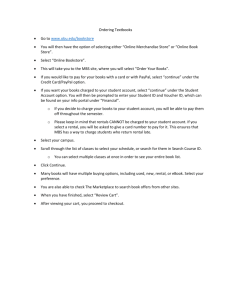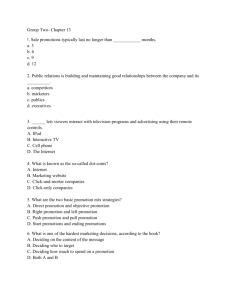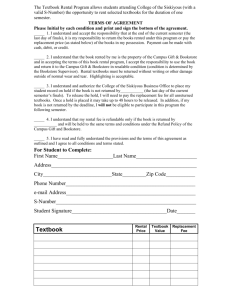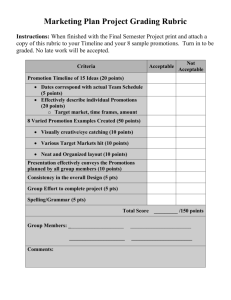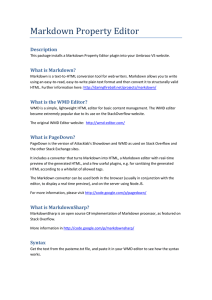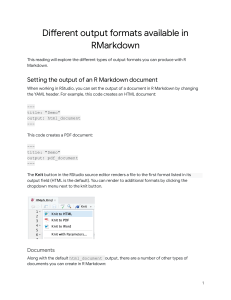You must have Microsft Word or Open Office Writer to view this
advertisement
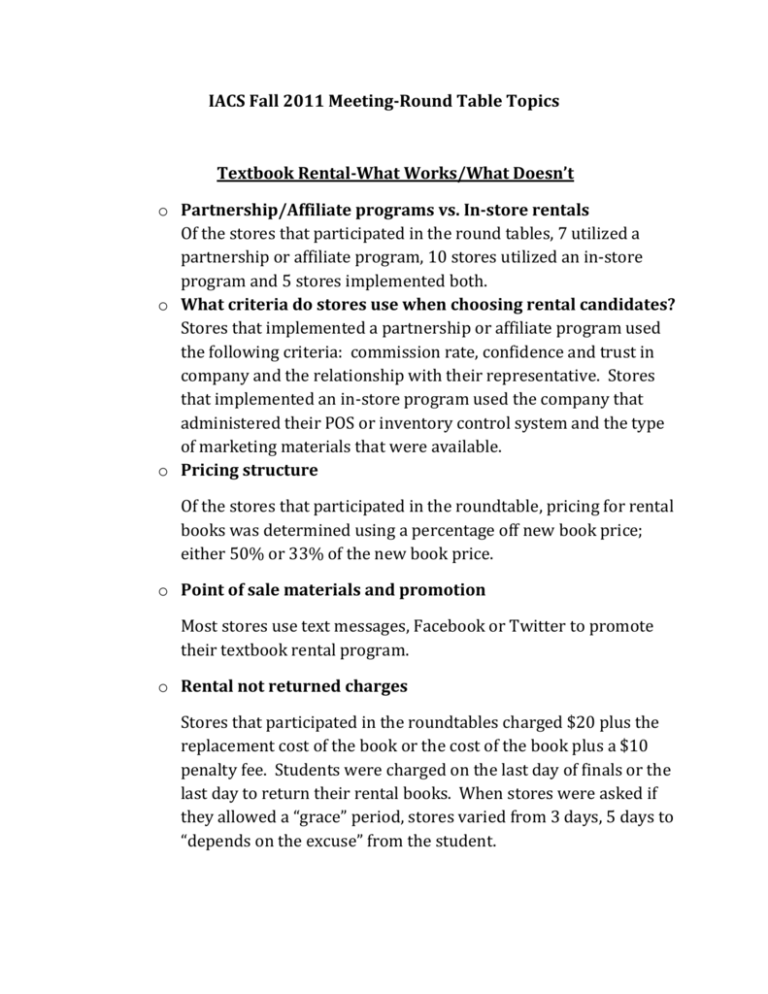
IACS Fall 2011 Meeting-Round Table Topics Textbook Rental-What Works/What Doesn’t o Partnership/Affiliate programs vs. In-store rentals Of the stores that participated in the round tables, 7 utilized a partnership or affiliate program, 10 stores utilized an in-store program and 5 stores implemented both. o What criteria do stores use when choosing rental candidates? Stores that implemented a partnership or affiliate program used the following criteria: commission rate, confidence and trust in company and the relationship with their representative. Stores that implemented an in-store program used the company that administered their POS or inventory control system and the type of marketing materials that were available. o Pricing structure Of the stores that participated in the roundtable, pricing for rental books was determined using a percentage off new book price; either 50% or 33% of the new book price. o Point of sale materials and promotion Most stores use text messages, Facebook or Twitter to promote their textbook rental program. o Rental not returned charges Stores that participated in the roundtables charged $20 plus the replacement cost of the book or the cost of the book plus a $10 penalty fee. Students were charged on the last day of finals or the last day to return their rental books. When stores were asked if they allowed a “grace” period, stores varied from 3 days, 5 days to “depends on the excuse” from the student. o How to increase your rental returned rate Stores used the following methods: emails (as many as 3-5), Facebook, Twitter, signage throughout the campus, phone calls to students. o Use of new technology (text message, phone messages, etc) Stores used Facebook, Twitter and mostly email. Merchandise Markdowns o Markdown Schedules, Timing and Percentages Of the stores that participated in the markdown roundtable, almost all stores did not use a markdown schedule. Stores varied greatly in timing and percentage of markdown taken from 25% after 12 months -> next markdown is 40% or 40% after 6 months -> next markdown is a “sale”. Stores indicated that rather than using a markdown schedule certain factors were taken into consideration: broken size runs were marked down more aggressively, children’s clothes and larger sizes (3X and 4X) were not marked down as aggressively, clothes that were not selling were moved to a better visible location before markdowns were implemented. One store said they might take two similar items with different retail prices down in price to a single point for higher impact. o Advertising Stores indicated that they used Facebook, emails to faculty and staff and in-store monitors to advertise their markdowns or sales events. One store advertises weekly to faculty and staff. o Placement of Clearance Items Most all stores had a clearance section in their stores. Stores placed their clearance section in the back of the store, highlighting new merchandise. One store mentioned that they hold regular sidewalk sales for merchandise that has already been marked down. They group markdown merchandise by price point $5, $10 and $15. o Marking Markdown/Clearance Items Stores in the round table most always used “sale” price stickers, many used different highlighter colors and a corresponding “% off chart”. o Write off vs. Donation Stores were against donating markdown or clearance items, not wanting the perception of the bookstore to be “trashy”. Stores opted instead for gift card donations to get traffic in the store. Creating Excitement in your Store o Creative promotions What type of holiday promotions do you offer? Store indicated they used the following holiday promotions, holiday open house (big discounts for the day including music by the music department), Kiss the IPOD (table with 7 couples to see who held an IPOD between their lips the longest), Costume contest (costume must include items purchased at the bookstore. What type of “back to school” promotions do you offer? Store in round table discussion used the following back to school promotions: coupons for $5 off backpacks, $3 off tshirts, food service coupons. What type of buyback promotions do you offer? Stores used the following promotions during back to school, Bonus Bucks (every $25 spent they get a $1 bonus buck for every $200 spent they get a $20 coupon), Wheel of Fortune, Scratch off cards (prizes are gifts wrapped under a tree that winner choose). What has been the most popular promotion your store has run? Popular promotions of stores were Midnight Madness 12:00 midnight sales-students come to bookstore in their PJ’s, Design a T-Shirt event and Commit to Win T-Shirts @ $5.00 o Bookstore events Does the bookstore hold any special events? Cafeteria fashion show was held at one college, the models wear bookstore merchandise and go table to table in the cafeteria to promote clothing. o Advertising to students What type of media do you use to advertise promotions to students? Facebook promotion are popular, one store held a 4 hour sale on the spur of the moment and did well. Security-How to Prevent Theft o Use of security companies Stores utilized the following during “rush” periods for security: Off duty Chicago Police Off duty State of Illinois Police Campus Police Armed guards on campus Unarmed retired police guards in store Staff member greets at door Staff member offers assistance Staff member at door checking bags like Wal-Mart Security walks through the store o Security systems Stores use the following for security: Checkpoint Cameras – monitored and non-monitored Canvas bags with zippers for reserved books being picked up Books tagged on inside and outside shrink-wrap Check your backpack at the door Have monitor for backpack check to prevent theft Don’t be shy about approaching student you think may be stealing Counter service for text books o Security during rush vs. the rest of the semester Close down the textbook area 2 weeks after rush Staff member assists students in text area after rush Radios to communicate if you have 2 level store Student going up with something Student ID’s are required to be visible to distinguish students from visitors o Security during buyback-what type of security do you use during buyback? Student ID’s required Communication between buyback person and bookstore Communication between all bookstores in the area
